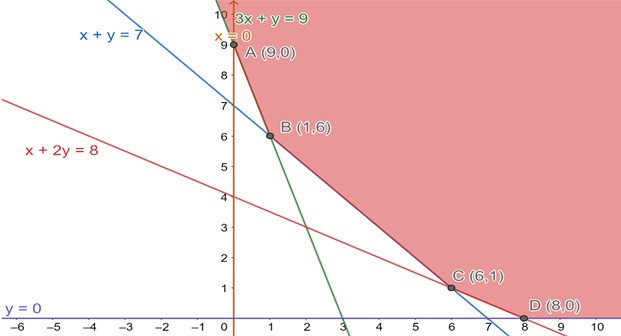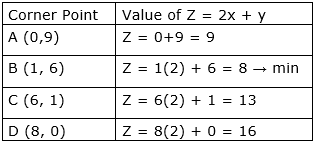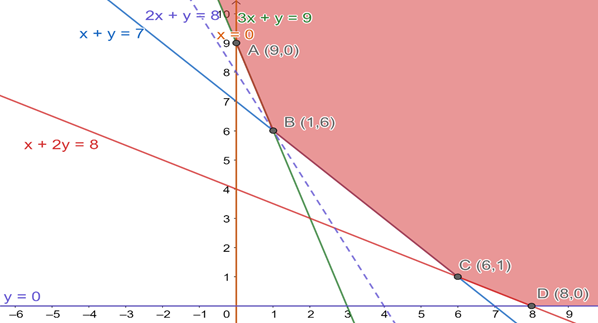In order to supplement daily diet, a person wishes to take some X and some wishes Y tablets. The contents of iron, calcium and vitamins in X and Y (in milligrams per tablet) are given as below:

The person needs at least 18 milligrams of iron, 21 milligrams of calcium and 16 milligrams of vitamins. The price of each tablet of X and Y is Rs 2 and Re 1 respectively. How many tablets of each should the person take in order to satisfy the above requirement at the minimum cost?
Let number of tablet X be x and number of tablet Y be y.
Iron content in X and Y tablet is 6 mg and 2 mg respectively.
So, total iron content from x and y tablets = 6x + 2y
Minimum of 18 mg of iron is required. So, we have
6x + 2y ≥ 18
⇒ 3x + y ≥ 9
Similarly, calcium content in X and Y tablet is 3 mg each respectively.
So, total calcium content from x and y tablets = 3x + 3y
Minimum of 21 mg of calcium is required. So, we have
6x + 2y ≥ 21
⇒ x + y ≥ 7
Also, vitamin content in X and Y tablet is 2 mg and 4 mg respectively.
So, total vitamin content from x and y tablets = 2x + 4y
Minimum of 16 mg of vitamin is required. So, we have
2x + 4y ≥ 16
⇒ x + 2y ≥ 8
Also, as number of tablets should be non-negative so, we have,
x, y ≥ 0
Cost of each tablet of X and Y is Rs 2 and Re 1 respectively.
Let total cost = Z
So, Z = 2x + y
Finally, we have,
Constraints,
3x + y ≥ 9
x + y ≥ 7
x + 2y ≥ 8
x, y ≥ 0
Z = 2x + y
We need to minimize Z, subject to the given constraints.
Now let us convert the given inequalities into equation.
We obtain the following equation
3x + y ≥ 9
⇒ 3x + y = 9
x + y ≥ 7
⇒ x + y = 7
x + 2y ≥ 8
⇒ x + 2y = 8
x ≥ 0
⇒ x=0
y ≥ 0
⇒ y=0
The region represented by 3x + y ≥ 9:
The line 3x + y = 9 meets the coordinate axes (3,0) and (0,9) respectively. We will join these points to obtain the line 3x + y = 9. It is clear that (0,0) does not satisfy the inequation 3x + y ≥ 9. So, the region not containing the origin represents the solution set of the inequation 3x + y ≥ 9.
The region represented by x + y ≥ 7:
The line x + y = 7 meets the coordinate axes (7,0) and (0,7) respectively. We will join these points to obtain the line x + y = 7. It is clear that (0,0) does not satisfy the inequation x + y ≥ 7. So, the region not containing the origin represents the solution set of the inequation x + y ≥ 7.
The region represented by x + 2y ≥ 8:
The line x + 2y = 8 meets the coordinate axes (8,0) and (0,4) respectively. We will join these points to obtain the line x + 2y = 8. It is clear that (0,0) does not satisfy the inequation x + 2y ≥ 8. So, the region not containing the origin represents the solution set of the inequation x + 2y ≥ 8.
Region represented by x≥0 and y≥0 is first quadrant, since every point in the first quadrant satisfies these inequations.
Plotting these equations graphically, we get

Feasible region is the region to the right of ABCD
Feasible region is unbounded.
Value of Z at corner points A, B, C and D –

Now, we check if 2x + y<8, to check if resulting open half has any point common with feasible region.
The region represented by 2x + y<8:
The line 2x + y=8meets the coordinate axes (4,0) and (0,8) respectively. We will join these points to obtain the line 2x + y=8. It is clear that (0,0) satisfies the inequation 2x + y<8. So, the region not containing the origin represents the solution set of the inequation 2x + y<8.

Clearly, 2x + y = 8 intersects feasible region only at B.
So, 2x + y<8 does not have any point inside feasible region.
So, value of Z is minimum at B (1, 6), the minimum value is 8.
So, number of tablets that should be taken of type X and Y is 1, 6 Respectively.